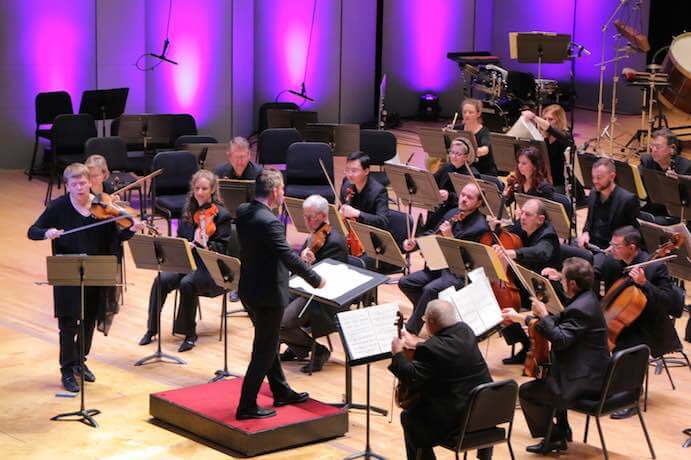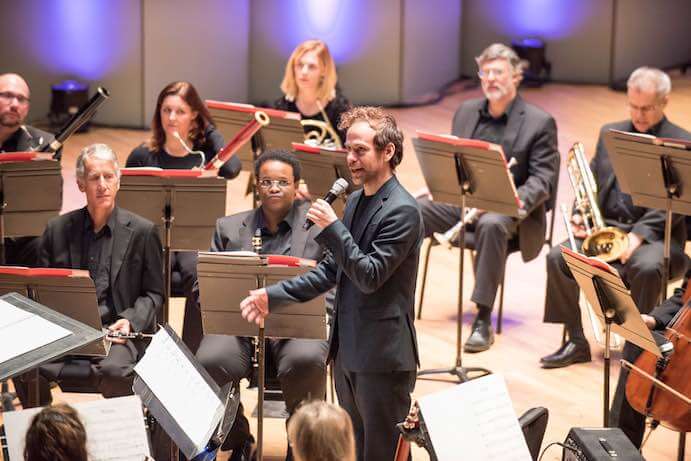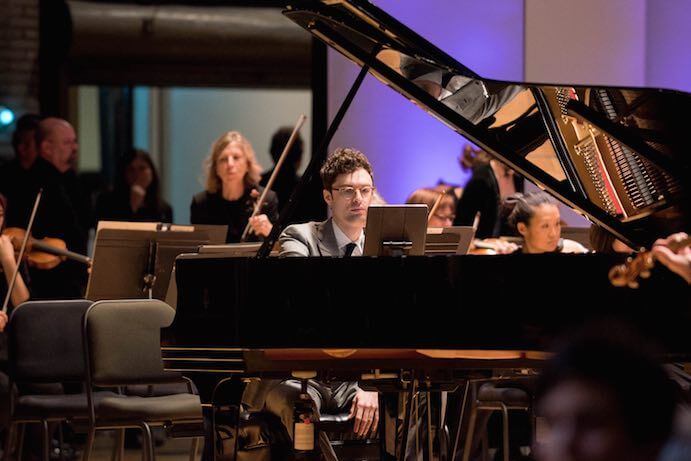Audience members poured back into Cincinnati’s Taft Theatre on Saturday, January 14th for the final evening of the 2017 MusicNOW Festival presented by the Cincinnati Symphony Orchestra and organized by Bryce Dessner. In addition to the previous evening’s program—which included works by Andrew Norman, Matthias Pintscher, and folk singer Lisa Hannigan—the Saturday evening program culminated in “a heroic amount of music,” according to Dessner. Heroic indeed were the efforts of the Cincinnati Symphony Orchestra, which offered remarkable performances of Anna Thorvaldsdottir’s Reflections, the Ligeti Violin Concerto, Timo Andres’ The Blind Banister, and the U.S. premiere of Bryce Dessner’s Wires.
The concert began with Anna Thorvaldsdottir’s string trio Reflections instead of the originally announced orchestral work Aeriality. Whatever the reason for the last minute substitution, it was unfortunate that the program pared down the festival’s only offering by a female symphonic composer. The short, single-movement Reflections is a journey from tone to texture that unfolds in a dark, glacial, and almost meditative manner. The works begins with the three instruments sustaining a single pitch from which other pitches gradually emerge. Harmonics, quarter-tone inflections, and sul ponticello scrapes unfold to form a new timbral foundation, yet expressive bowed tones continue to sing through this more complex soundscape. Finally, a technique of dampening the strings with the entire left hand completes the tone-to-texture shift and leaves the audience with the feeling that they have traveled somewhere, yet perhaps without arriving anywhere. The work was performed well—however, opening with a substitute piece of chamber music on an otherwise symphonic program seemed only marginally better than removing Anna Thorvaldsdottir from the program altogether. Though the otherwise heroic efforts of the CSO seem to have fallen short in preparing the originally planned work, Reflections felt out of place within the larger context of the programming.

Pekka Kuusisto with the Cincinnati Symphony Orchestra–Photo courtesy of the Cincinnati Symphony Orchestra
The program continued with a breathtaking rendition of György Ligeti’s Concerto for Violin and Orchestra, performed with absolute mastery by Finnish violinist Pekka Kuusisto. Dessner returned to the stage to introduce the concerto—the one “historical” work of the festival—as a “doorway through which to understand the other pieces on the program.” While the Cincinnati Symphony Orchestra navigated scordatura tuning, ocarinas, recorders, and a highly challenging score with relative success and minimal irregularities, the majority of the praise goes to Kuusisto’s riveting and virtuosic playing. What was most striking about Kuusisto’s command of this concerto was the multitude of ways in which his playing was captivating. This versatility included high-energy frenetic technique, beautifully-sustained phrases in slower passages, a self-aware stillness when the orchestra was in the foreground, and aggressive angular outbursts. The culminating showcase of Kuusisto’s ability was the cadenza, which featured wild oscillations between harmonics and left-hand pizzicato, interacting with ghostly recorders and ocarinas, and whistling/singing while playing, all performed with a smile. Anyone who can master Ligeti with a smile on their face is a true champion of contemporary music.
Timo Andres’ piano concerto The Blind Banister—featuring the composer as the soloist for the first time—continued the theme of process-driven music that had been briefly explored in Anna Thorvaldsdottir’s Reflections. The thing that is perhaps most appealing about Andres as a composer is his penchant for starting with simple musical elements and developing them through a perceptible process. Inspired by the fault line between disparate styles in Beethoven’s second piano concerto, The Blind Banister is an exploration of two main elements: descending scales and ascending scales. While this sounds dull and tedious, there is a beauty to the way in which this delicate simplicity unfolds. The work opens with a scale slowly meandering downward against a sea of steady, pulsating chords. Andres takes his time presenting this sonic table of contents, and the patient yet deliberate placement of each consecutive note of the scale is reminiscent of the gradual process found in early American minimalism. Major second suspensions begin to rub against the descending scale, and these two-note pairs start to take hold throughout the entire orchestra. While the concept of descending and ascending scale patterns permeates the entire concerto and remains the primary focus, Andres’ colorful orchestration (featuring solo piccolo, solo oboe, pizzicato violin, and col legno low strings) weaves a gorgeous tapestry that serves as the backdrop for these simple musical elements. Though there were passage where the ensemble overpowered Andres, his technical virtuosity at the piano was brilliant throughout.

Bryce Dessner–Photo courtesy of the Cincinnati Symphony Orchestra
The evening concluded with the U.S. premiere of Bryce Dessner’s Wires. Originally commissioned/premiered by Ensemble Intercontemporain (with conductor Matthias Pintscher), Dessner chose to write himself into the ensemble rather than functioning within a traditional concerto soloist/accompanying ensemble model. Wires begins with a sequence of lush chords articulated by percussion that dissolve into more complex sonorities akin to the harmonic language of Ligeti and Helmut Lachenmann. Rather than retaining a distinctly American voice for this commission, Dessner chose to incorporate and emulate the voices of composers from Ensemble Intercontemporain’s standard repertoire. Moments of sustained electric guitar (produced by using an EBow) intertwine with brassy swells, metallic percussion, and pitch bending woodwinds. Rapid fire woodwind and percussion articulation bursts out of sustain tones. Eventually, the electric guitar, drum set, and col legno strings establish a groove, which builds to a wash of bass drum and tam tam to bring the piece to an epic conclusion. Dessner successfully synthesized many styles and influences with his own, and hopefully this will encourage further collaboration between American composers and Ensemble Intercontemporain.
The MusicNOW festival is an outstanding event that unapologetically lives at the intersection of folk, pop, and contemporary classical music. As evidenced by the audience demographic on both Friday and Saturday evening, this festival is clearly serving as a gateway to new music by combining music and artists that both stretch and delight audience ears.























